When you deliver for Doordash, you are your own boss. That means you have control over how much money you can make.
You may be applying for Doordash. Maybe you met the requirements to Dash and have signed up, and are getting started as a new Dasher. Or perhaps you’ve been at it for a long time and are just looking to up your game.
I’ve learned from over four years of delivering full-time in the gig economy that several strategies and tips can improve earnings on Doordash. I’ll share the four most important strategies and 31 tips and tricks for how to make more with Doordash.
Here’s a bonus. If you really want to go to the next level, this is only part of a series of articles about the things you need to know when delivering for Doordash. We’ll link to other articles in the series where appropriate, and you can find a complete list of articles at the end of this post.
The four most important strategies for making more with Doordash
If you want the TL;DR (Too Long; Didn’t Read), four major strategies can make a massive difference in your Doordash earnings. Each of the 31 Doordash driver tips and tricks falls under one of these strategies.
- Treat this like a business, not a job
- Be strategic about how you deliver and what deliveries you accept
- The single best way to improve earnings is to deliver quickly and efficiently
- Keep the money you make from slipping out the back door
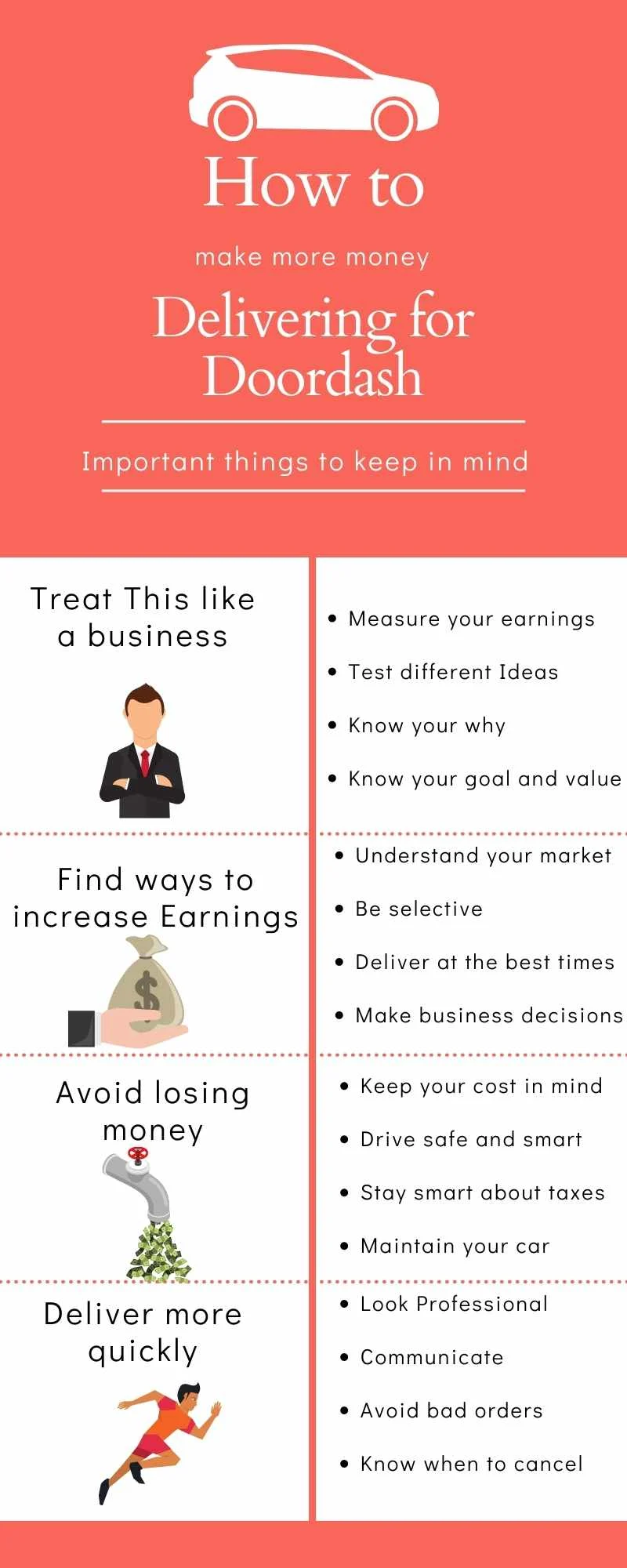
We’ll break each of these strategies down and look at the delivery tips that fit within them.
Remember that everyone’s situation is different. Some of these will be better for you than others. Because you are the boss of your own business as an independent contractor, you can determine how to implement these ideas most profitably.
The Best 31 Doordash Driver Tips to Help You Make the Most Money
- 1. Think in terms of profit, not the money you get from Doordash
- 2. Be goal-oriented
- 3. Set your price
- 4. Make good decisions about what deliveries to take
- 5. Know when incentives make sense and when they don’t
- 6. Multi-app
- 7. Pick the right places to deliver
- 8. Know the best times to deliver
- 9. Know when Top Dasher makes sense
- 10. Use the Loss Leader principle
- 11. Decide when its best to schedule and when to Dash Now
- 12. Provide excellent customer service
- 13. Find other side hustles you can do at the same time
- 14. Refer friends and family
- 15. Share your experiences and ideas
- 16. Look the part
- 17. Find tools that improve efficiency
- 18. Learn the best parking spots and traffic patterns
- 19. Know when to cancel out of an order
- 20. Deliver stacked orders (and know when to avoid them)
- 21. Evaluate offers based on delivery time
- 22. Communicate with the customer
- 23. Drive fewer miles
- 24. Look into bicycle delivery
- 25. Track your miles and expenses
- 26. Choose the best vehicle and keep it running
- 27. Make sure you’re insured properly
- 28. Document your deliveries
- 29. Save for taxes and expenses
- 30. Avoid Fast Pay
- 31. Keep your phone working
Doordash Strategy #1: Treat this like a business, not a job
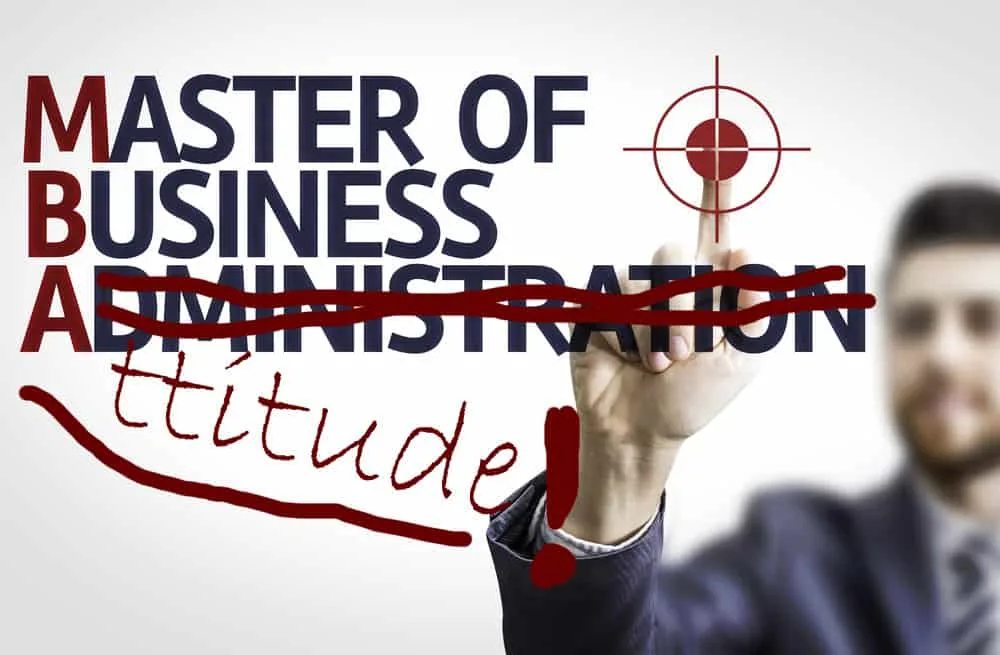
If one strategy is the most important, this is the one.
Developing a business mindset lays a foundation upon which all other techniques and tips can be built.
Why is this so important? Because when you agree to the Doordash Independent Contractor Agreement, you agree to provide services as a business, not as an employee.
You are running a business. As an independent contractor, you’re self-employed. Doordash isn’t allowed to manage you like they can an employee.
When you take that to heart and treat it like a business, you take control. If you decide to look at this as a delivery job, you give Doordash the power.
When you look at this like a business owner, Doordash is not your boss. They’re your customer. That fact changes the dynamic of the relationship in a huge way.

1. Think Profit
As an independent contractor, you’re on your own for expenses. Doordash doesn’t pay for gas or other expenses. That all comes out of your pocket.
Your Doordash taxes are business taxes. The IRS does not see your payments from Doordash or customer tips as your income. Instead, your profits become your actual earnings.
This is why our final strategy is to keep your money from slipping out the back door. When it’s all said and done, the most important measure is not how much money you get from Doordash. It’s how much is left in your pocket.
Perhaps the best measurement of what you make is profit per hour. I calculate that by subtracting 30 cents per mile from my gross earnings and dividing by the time I’ve been delivering. This measurement can help you compare a single delivery to an entire year’s worth of deliveries.
If you track it closely, you can use profit per hour to test your different strategies. You can see when things are getting better or getting worse. It’s the best way to measure a single delivery or your progress for the day, week, or year.
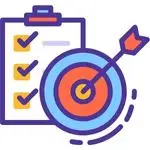
2. Be goal oriented
What is it you’re trying to accomplish? Why are you delivering for Doordash? Why is that goal important? Understand your why, and what you want to accomplish.
Business owners who know what they want to accomplish are more likely to succeed. Your goals may be financial or personal. Remind yourself what you’re going after, and that will motivate you.
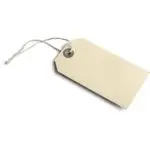
3. Set your price.
Did you know you can set your own price when delivering for Doordash? While, unfortunately, you can’t negotiate delivery fees, you can establish a price by accepting and rejecting delivery offers.
One of the best ways to do this is to determine what your time is worth. Establish an hourly rate that covers your time and expenses. I use a 50-cent rule, where a delivery has to pay 50 cents a minute or better for me to accept it.
Doordash Strategy #2: Be strategic with your deliveries

The beauty of being an independent contractor is the flexibility. You can use that to your advantage by making choices that bring more money into your bank account.

4. Make the right decisions about what deliveries you accept.
You have the right to reject delivery offers. Use that right. That $2.50 delivery that takes a half hour to forty-five minutes won’t make you much money. Your Doordash acceptance rate isn’t as important as your profit per hour.
When Doordash offers a delivery opportunity, ask yourself if it meets the price you set in Tip #3. That offer is a bid for your services, not an employee assignment. If it meets your price, take it. Pass if it doesn’t.
Find your sweet spot. If you decline too many offers, the idle time between deliveries can cut into your profits. A good rule of thumb is that when delivery offers come frequently (within a minute or less per offer), you can be far more selective. You may need to adjust your criteria if it’s several minutes until you get the next request.

5. Know when to take advantage of incentives
When Doordash thinks they need more drivers, they will try to sweeten the pot with incentives. A popular one is Peak Pay, a bonus added to every delivery during certain times in particular zones.
Another incentive is called Challenges. They may offer a bonus or a guaranteed amount when you complete a minimum number of deliveries in a given period.
You can often make more money because of incentives. However, use caution. That’s because sometimes those incentives draw all the other Doordash drivers out of the woodwork, leaving too many drivers logged in for the number of orders. When that happens, longer waits between offers can cost you more than the incentive adds.

6. Multi-app (deliver for more than one company)
Remember that Doordash is your customer, not your boss. It’s never good to depend too heavily on one customer. If you have several food delivery apps bidding for your services, you are less likely to be hit by slow periods. This allows you to be more selective.
If Doordash won’t meet your price, there’s a good chance someone like Grubhub or Uber Eats will.
Multi-apping is a skill that needs to be developed. Dealing with pings and chimes on several delivery apps can be overwhelming.
Working several apps at once can work against you. Suppose you take on multiple deliveries for different food delivery services simultaneously. In that case, you run the risk that one or more deliveries can be late. This puts you at risk of violating your agreement with Doordash.

7. Pick the right places to deliver.
You have the right to choose which part of your market makes sense for delivery. That allows you to position yourself in areas with higher profit potential.
Doordash will often recommend hotspots, which are areas with several restaurants and high order volume. Sometimes it’s better to gravitate toward those hotspots. Other times the hotspot may draw too many other Dashers and saturate the area.
There was a time I used to avoid downtown in my market because traffic and parking were a nightmare. However, I found downtown far more profitable once I learned how to navigate those issues.
Some drivers may find the suburbs to pay better because traffic and tips are better. My experience has been the opposite, as drives are longer on average, taking more time.
My favorite strategy around where to deliver is called the vacuum principle. When incentives and hotspots draw Dashers into a particular zone during high demand, it creates a vacuum in surrounding areas. I find that it’s often more profitable to fill the vacuum where I can stay busy and be more selective than to be stuck with long waits in busy areas.

8. Figure out the best times to deliver
Peak hours, such as from 10 AM to 2 PM or 5 PM to 9 PM, are often the best times to be out there. I track every delivery and find that I make the most profit per hour during those times. Dinner hours are a slightly better paying time of day than lunch hours for me.
Bad weather can be another great opportunity. People who don’t want to go out often in the rain or snow may order deliveries. Many drivers choose to stay home, leading to less competition for Doordash orders.
Know when things are slow for your area. Often mid-day means fewer offers and longer pauses between deliveries. Tuesday night is often the least profitable.
Keep in mind that the vacuum principle can apply here. If too many drivers are grabbing those busy times, they may leave things wide open during non-peak hours. Know how things work in your area and when you can make the most money.
Pay attention to events that may lead to more food delivery orders. Football season can lead to more deliveries on Saturdays, Sundays, and Monday nights. Popular TV events such as awards shows and series finales often have people ordering food for delivery.

9. Know when Top Dasher makes sense.
Doordash has a program called Top Dasher. If you meet specific requirements by the end of the month, you may get Top Dasher status. The best thing about Top Dasher is that you can Dash any time regardless of your zone’s availability.
I’ve done some experiments and found that Top Dasher status did not make a difference in the quality of delivery offers I was getting from the Dasher app. The only true benefit I’ve seen is the ability to Dash at any time in any zone. If you find it difficult to get on the schedule in your market, that one perk may make it worthwhile.
On the other hand, the high acceptance rate requirement (70%) may be too costly. My experience is that I make significantly less when I accept that many deliveries.

10. Use the Loss Leader principle
Many stores use what’s called a loss leader. They’ll advertise some items at a loss to draw people in, knowing the customer will buy other things with a higher profit margin.
You can use the loss leader principle with some low-paying orders. Some deliveries don’t make sense on their own but might still help you make more money. For instance, suppose you’re on your way home or heading to a more profitable area after completing an order. A lower-paying offer within your route lets you make a little money along the way.
Another scenario is if you must wait long for food to be ready at a restaurant. You may find a short, quick offer on another platform that doesn’t pay much but can be finished before the food is ready.
Many Doordash orders don’t pay well enough on their own to accept. However, you can sometimes fit them in and make a few dollars more without additional time and effort.

11. Know when to schedule your Dashes and when you can Dash Now.
Doordash limits how many Doordash drivers can log into a particular zone at a given time. The schedule is rarely full in some markets, while others have all the slots filled up well in advance.
If you are in one of the busier zones, it may be better to schedule ahead of time. You can reserve a time slot+ up to five days in advance. If you meet the following requirements, you can get access to the schedule a day earlier:
- Minimum customer rating of 4.6
- Completion rating of 95% or better
- Have completed either five deliveries in the past week or 500-lifetime trips.
Scheduling ahead is a good way to ensure the ability to deliver when you want without relying on Top Dasher status. However, it can give you less flexibility by locking you into certain times and zones.

12. Provide excellent customer service.
Make it easy and pleasant for the customer to get their food. Be friendly and prompt in your communication with them. If it’s an in-person delivery, be nice and thank them.
Good customer service benefits you in two ways. One, it helps you complete deliveries more quickly with fewer headaches. Second, sometimes it can lead to an additional customer tip amount.
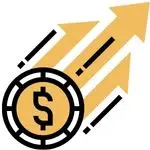
13. Find other ways to earn when delivering.
Can you make money by having your car wrapped with advertising? Some folks pick up scooters to charge while out on deliveries. There are several side hustles that you can incorporate into your time out on deliveries.
Kevin Ha of FinancialPanther.com wrote about making extra money on Job Spotter by taking pictures of help wanted signs while out on deliveries. While that app has since closed down, it’s a great example of ways you can make a little extra money while out and about.

14. Refer other delivery workers.
Doordash often offers a referral bonus in different areas. For instance, they may offer a $200 bonus if you refer someone who completes 270 deliveries within 60 days. The person referred may have guaranteed total earnings if they also meet that goal.
The referral amount can fluctuate depending on Doordash’s need for drivers in your area. They may not offer any such bonus if they have a waiting list in your market.
Understand that the referred person may not meet the Doordash requirements or pass the background check. Also, the example of 270 deliveries in 60 days usually requires about 15 hours weekly, which is a pretty heavy commitment.

15. Share your experience.
People are always looking for guidance delivering for Doordash. Several gig workers make money on YouTube or TikTok talking about what they do. You’ll notice that this website has advertising. I know someone who makes a living coaching new drivers through their referral periods.
Be creative in finding ways to use your experience Dashing to help others.
Doordash Strategy #3: Deliver More Quickly

It’s as simple as this: the more deliveries you can complete in a given time, the more money you can make.
We usually focus on how much we make on a particular delivery. The problem is that there are limits to what we can do there.
However, you can control your efficiency.
Over nearly four years of delivery, I’ve witnessed all the major food delivery companies slashing their base pay. And yet, while delivery fees keep decreasing, my hourly pay (profit) has grown yearly.
How did that happen? Be getting a lot more deliveries per hour. I became quicker at deliveries. I could complete more deliveries in a given time by reducing the time deliveries take.
This is the one thing you have the most control over regarding increasing your hourly profit. Finding ways to complete more deliveries in less time is probably THE best way to make the most money on Doordash.

16. Appearance gets you in and out of the restaurant quicker.
Perhaps the one thing that can slow you down the most is how long it takes to get out of the restaurant on meal deliveries. There are two issues here: getting staff’s attention and waiting for the food to be prepared.
We can’t do much about the preparation time. However, one tip will do more than anything else to get the staff’s attention: Look the part.
Restaurant employees are often extremely busy handling customers and food orders. Many local restaurants are short-staffed. Often, they can’t tell whether it’s a customer or a food delivery driver trying to get their attention.
If your appearance makes it clear you are there to pick up a delivery, that can speed things up tremendously. A professional appearance and the presence of a delivery hot bag is the best non-verbal way of saying you’re there to pick up an order.
It catches their attention and skips the part where they ask what you’re there for. More often than not, staff skips right to the part where they ask who you’re picking up for.
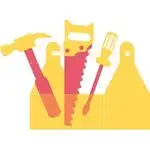
17. Get tools that make you more efficient.
Several essential and helpful tools help you be a better Dasher. Look for things that can help you deliver quickly and efficiently.
The standard Doordash delivery bag won’t cut it for larger customer orders. A good catering bag (or selection of them) can help you quickly get the restaurant’s orders to your car and then to the customer.
Choose a good navigation program to help you get around. Check out tools like the Beans app, which enables you to locate specific apartments inside complexes.
There are a number of deliveries where the standard issue Doordash bag won’t cut it. Sometimes you get larger orders and not having a good bag will leave the restaurant and customer disappointed. Pick up a good catering bag and a good pizza bag. Invest in something firm that is easy to get food in and out of.

18. Learn how to get around and where to park
Circling the block and looking for a parking spot can kill your delivery times. Getting stuck in traffic can be brutal.
One of the best things you can do, especially in congested and high-traffic areas, is to familiarize yourself with all the go-to parking spots. Are there loading zones you can use? It’s often faster to park directly at a location you know will be available and walk a bit than to drive around searching.
Get to know how traffic patterns work in your area. What routes get you moving faster, and which tend to bog you down? Learn when the shortcuts are time savers and when you get stuck waiting to proceed.

19. Know when to cut your losses
Sometimes the restaurant or merchant is running behind. You arrive and find out the order won’t be ready for a half hour or longer. Or maybe it’s an order-and-pay delivery and will take far longer than expected to place the order.
Is it worth waiting? Sometimes it is. If the delivery pays enough to cover that wait time and still pays good money, it’s better to stick around. If the wait time means your earnings rate is minimal, it might be time to cut your losses, unassign yourself from the delivery, and move on.
I usually evaluate based on expected earnings per minute. I’ll estimate how long it will take from that moment until I complete the order and divide the pay by the estimated minutes. If that pay per minute is significantly lower than the price I’ve established (for me, it’s 50 cents per minute), I’ll cancel the delivery and move on.
Use a similar approach when dealing with driver support. Some situations lead to some additional pay, but you must contact support to get it. You have to decide whether it’s more profitable to move on to the next delivery or spend that time dealing with support.

20. Know when stacked deliveries make sense.
Doordash may offer you a stacked order, with two or more orders to be delivered. Other times, they may ping you with an additional delivery after you’ve accepted one.
Two orders going the same direction can sometimes let you make twice the money in close to the time it usually takes for one. This is a great way to cut down your average delivery time.
Other times, the additional pay isn’t worth the extra time. Sometimes Doordash will sneak in a low-paying or no-tip order on top of a higher-paying delivery. Or perhaps the restaurant has one offer ready but a long wait for the other.
When you are good at estimating the time involved, you can get a good feeling for when it makes sense to stack deliveries and when it’s better to pass.

21. Evaluate offers based on estimated delivery time
In my experience, the best single factor for choosing whether to accept an order is how long I think it will take. In tracking every delivery, I’ve found that quick delivery time is almost always a better indicator of a profitable delivery than the dollar amount.

22. Communicate with the customer.
The biggest bottleneck to a quick delivery is at the restaurant. The second largest is connecting with the customer.
Are there good instructions? Did they provide a door entry code? Is the customer coming downstairs to meet you at the entrance of their high-rise?
If there’s any question that you’ll have trouble at the customer’s location, contact them immediately. Send a message through the Doordash app letting them know how the order is coming and ask for clarification. Do this quickly, as the customer often doesn’t see your message immediately.
Doordash Strategy #4: Avoid losing money

Remember that the most important thing here is not how much money you get from Doordash but how much is left in your pockets when all is said and done.
One of the most effective ways to increase profits is to keep expenses down. You want to bring in as much money as possible, but you also want to keep it from slipping out the back door. These Doordash tips will help you do that.

23. Drive less
The best way to save money on gas is to drive less.
Driving too far can suck up a lot of your money. It’s not just the cost of gas but all the wear and tear on your car. I call it a credit card on wheels because every mile you drive adds an expense that you’ll just pay later. It brings you a mile closer to big-ticket repairs and leaves a bit less in your pockets when you sell because of decreased value.
Avoid long-distance trips if they don’t pay well enough to compensate for that cost. Focus on areas where orders go shorter distances.
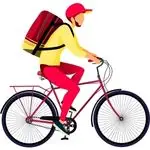
24. Consider whether bicycle delivery makes sense
Bike delivery can be incredibly profitable for a couple of reasons. In congested areas, you may be able to get around faster than trying to drive your car. Using a bike doesn’t have the same fuel, insurance, depreciation, and maintenance costs as using your personal vehicle.

25. Track your expenses and miles.
You can deduct 70 cents per mile from your taxable income (2025).
Suppose you drove 1,000 miles and earned $1,000. In that case, you would subtract $700 from your income and only pay tax on the remaining $300. That’s a huge difference.
The same is true with other business costs (hot bags, app subscriptions, etc). All of that is deductible regardless of whether you itemize tax deductions.
For those in the 10% income tax bracket, with 15.3% self-employment taxes, every dollar in costs claimed reduces taxes by 25 cents.
In the example above, that $700 mileage deduction results in $177 less paid in taxes.
However, you have to have a record of it. You need to know what those deductions are to claim them. Keep track with a notepad or spreadsheet or check out mileage tracking apps like Hurdlr.
Once you figure out how to do Doordash taxes, claiming your legitimate business deductions is just as effective as increasing your profits by 25%. We talk more here where we answer questions like what can you write off for Doordash.

26. Get the right vehicle and keep it running.
If your form of transportation doesn’t work, you can’t make money with Doordash. This is known as opportunity cost.
In my experience, the ability to keep delivering is more important than fuel efficiency. The cost of not delivering is greater than the cost of gas.
Having the right car for Dashing makes a ton of difference in your profitability. Keeping up on the maintenance is just as important. Failure to do either will limit the potential amount of money you could make.
These are the main criteria for what you drive:
- It must be comfortable. Driving a car you hate can kill your motivation and reduce the time you make money.
- It has to be reliable. You can’t dash when it’s in the shop.
- Fuel efficiency. Gas costs have skyrocketed lately, so finding an efficient car that meets the other criteria is the best situation.

27. Get the right insurance.
This is one where you may have to spend money to avoid losing a lot more of it.
Most personal insurance policies specify that they don’t cover you while “transporting goods or services for hire.” Doordash doesn’t insure you either. In other words, you’re likely uninsured while Dashing, meaning you’ll pay for damages out of pocket if there’s an accident.
That cost is far greater than the cost of the right insurance. Understand your coverage. If your policy doesn’t cover you while delivering, you have the following choices:
- Find out if they have an upgrade that will cover you.
- Switch insurance to someone who will cover you.
- Stop delivering. The risk of being uninsured is too great.

28. Document your deliveries.
There’s a problem with illegitimate deactivations on Doordash. You can be accused of stealing food or deliberately taking too long to deliver.
Either of those will end your ability to keep earning.
I personally record everything I do. I use a dashcam .that has movable cameras and point the camera at the customer’s door when I drop off their order. Along with that, I use the free X-Recorder mobile app, which records everything that happens on my phone.
Bryan Greenling of LegalRideshare told me that a dashcam is the most important investment you can make for your business. Proving your case could prevent substantial future losses.

29. Save for taxes and expenses.
Put aside money each week for Doordash taxes. The more you make, the more you will owe. Tax day rolling around with you unprepared can be a significant distraction. The penalties and interest can cut into your bank account.
We talked earlier about how much it costs to drive. The thing about using your car for gig work is that you will wear your car out. It’s inevitable. If the time comes that you need new tires but don’t have the funds, you may be unable to continue delivering.
A good practice is to set money aside regularly to cover future costs. I personally put aside 30 cents for each mile and use that fund for gas, maintenance, and future repairs.

30. Stay away from Fast Pay.
Doordash’s Fast Pay feature lets you withdraw earnings immediately, rather than waiting for the direct deposit to hit the following week. However, they charge $1.99 each time you use Fast Pay. Using the instant payment feature five times a week will cost $517.40 annually.
The best practice is to wait for Direct Deposit, usually on the following Tuesday, which is free. If you do so, you’re more likely to set aside money (previous tip).
If you must get your funds immediately, consider using the DasherDirect card from Doordash, which has no transaction fee.

31. Keep your phone working.
Your phone dying will kill your ability to earn. Keep a charger or battery pack with you. Use a cell provider who has good coverage in your area. Know the dead spots for your cell service and avoid them.
If you have spotty coverage, getting a backup may be worth it. Look into a phone or data hotspot from another provider that can fill in the dead spots.
Finally, make sure your wi-fi is disabled on your phone. Otherwise, it can try to connect with other wi-fi signals and interrupt your data connection with your cell company.
That’s a lot of ideas, isn’t it?
Some are far better for you than others. Ultimately, with you being the boss of your own business, it’s up to you to test these ideas and figure out which ones work and which don’t.
Don’t do any of these because I told you to. These are here to help or inspire. In the end, you’re the one who knows your market and your personal style the best. Put together your own strategies to help you be the most profitable Doordash delivery driver possible.
In the end, you have to decide if your Doordash review is that it’s a good opportunity or not. It can be great if you like the freedom and flexibility of being your own boss. However, this might not be for you if you’re looking for a job.
But the beauty of working in the gig economy is that you control your work. You can choose the tips and tricks that help you make more on Doordash or any other platform. The above is a list of ideas you can start with. You’ll probably have your own ideas. What you do with it all is up to you.


